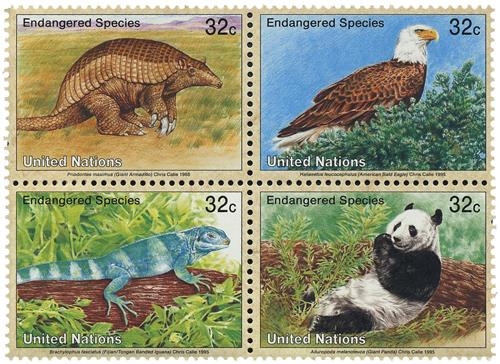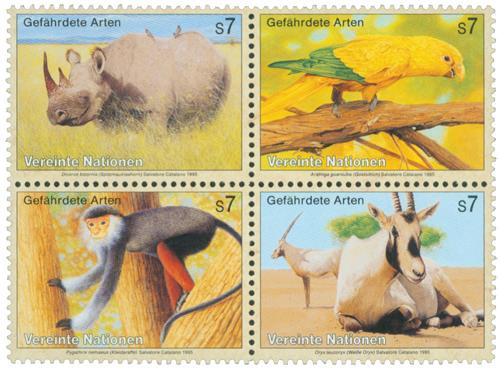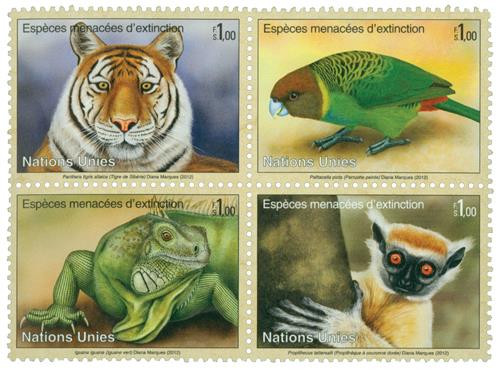
1995 Endangered Species
# UN657-60 - 1995 Endangered Species
$4.50
1995 Endangered Species
UN Offices in New York
UN Offices in New York
This is the third installment of the U.N.’s multi-year Endangered Species series. First issued on March 3, 1993, the series draws attention to the need for protection of endangered species around the world. One sheet was issued for each of the U.N.’s offices. Each sheet of 16 stamps features four different endangered species in setenant blocks. The New York sheet called attention to the plight of the giant armadillo, American bald eagle, Fijian/tongan banded iguana, and giant panda. U.N. Geneva’s stamps feature portraits of the crowned lemur, giant scops owl, Zetek’s frog, and wood bison. Examples of black rhinoceros, golden conure, douc langur, and Arabian oryx grace U.N. Vienna’s stamps.
Endangered species are those which are threatened with total extinction. Biologists consider a species endangered if it is expected to die out completely in 20 years. Most species become endangered due to four main human activities: destruction of habitat, wildlife trade, over hunting, and competition with domesticated animals. Destruction of habitat poses the greatest threat to wild species. Most wildlife is specially adapted to certain environments and conditions. When habitat disappears, dependent wildlife no longer has a home. The wildlife trade involves the capture of animals for pets, zoos, and research. Over hunting of certain species has occurred all over the world. Many fragile ecosystems have been destroyed by the introduction of domesticated animals, such as the U.S. songbird population which has been threatened by the increasingly large number of domesticated cats.
1995 Endangered Species
UN Offices in New York
UN Offices in New York
This is the third installment of the U.N.’s multi-year Endangered Species series. First issued on March 3, 1993, the series draws attention to the need for protection of endangered species around the world. One sheet was issued for each of the U.N.’s offices. Each sheet of 16 stamps features four different endangered species in setenant blocks. The New York sheet called attention to the plight of the giant armadillo, American bald eagle, Fijian/tongan banded iguana, and giant panda. U.N. Geneva’s stamps feature portraits of the crowned lemur, giant scops owl, Zetek’s frog, and wood bison. Examples of black rhinoceros, golden conure, douc langur, and Arabian oryx grace U.N. Vienna’s stamps.
Endangered species are those which are threatened with total extinction. Biologists consider a species endangered if it is expected to die out completely in 20 years. Most species become endangered due to four main human activities: destruction of habitat, wildlife trade, over hunting, and competition with domesticated animals. Destruction of habitat poses the greatest threat to wild species. Most wildlife is specially adapted to certain environments and conditions. When habitat disappears, dependent wildlife no longer has a home. The wildlife trade involves the capture of animals for pets, zoos, and research. Over hunting of certain species has occurred all over the world. Many fragile ecosystems have been destroyed by the introduction of domesticated animals, such as the U.S. songbird population which has been threatened by the increasingly large number of domesticated cats.











